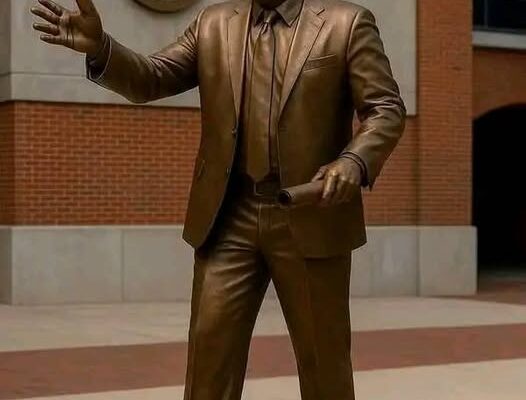Since his arrival in 2014, Bruce Pearl has transformed Auburn basketball from an afterthought into a national powerhouse. That transformation is more than wins and rankings; it’s about culture, energy, and community. With each milestone—from SEC championships to Final Four runs—Pearl has solidified himself as a living legend. Now, whispers of a life-sized bronze statue at the front of Jordan-Hare Stadium near Tiger Walk mark the earliest steps toward his permanent enshrinement in Auburn lore.
Auburn boasts a storied tradition of immortalizing great figures:
Jordan–Hare Stadium Statues (2021): Bronze sculptures of Cliff Hare, Ralph “Shug” Jordan, and Pat Dye now stand at the stadium’s southwest corner, honoring a player-administrator, a legendary coach whose name the stadium bears, and a coach/AD who modernized AU football Charles Barkley (2016): Auburn Arena added a statue of Barkley, the “Round Mound of Rebound,” to pay tribute to his global impact on basketball and philanthrop
These enduring tributes link present-day fans with the institution’s golden eras, creating a lineage of excellence that extends from the court to the campus.
Before Pearl’s arrival, Auburn basketball was on life support—just two NCAA Tournament appearances since the 2000s, minimal investment, waning fan interest. Pearl came in like a whirlwind, dunk-tank promotions, baby-kissing tours, and boundless passion. He ignited a transformation that extended far beyond the court .
In his nearly 11-year tenure:
Became Auburn’s winningest coach with over 214 victories, surpassing coach Joel EavesLed the Tigers to their first-ever Final Four in 2019.Guided Auburn to SEC regular-season titles (2018, 2022) and SEC Tournament championships (2019, 2024) ).Achieved the program’s first-ever No. 1 AP ranking (2022), with potential to repeat .
His approach redefined Auburn basketball, shifting expectations from mediocre to elite.
Pearl isn’t just a coach; he’s a catalyst. Shirtless pregame celebrations at Jordan-Hare, joining student sections, high-fives with legends like Cam Newton—these moments blur lines between coach, fan, and community ). Auburn fans respond in kind—calling for “Bruce Pearl Court,” renaming Neville Arena, or simply shouting “Build the statue of our king now”
- Tiger Walk is the iconic athlete procession leading to Jordan–Hare Stadium—a symbolic junction for sacrifice, hope, and dread.
- A Bruce Pearl statue, placed nearby, would greet fans and players alike, framing his legacy within Auburn’s pulse.
Drawing from Auburn’s precedent:
- Lou Cella, sculptor of the Daniel statues, used meticulous research and personality capture in his work
- Pearl’s statue would ideally echo his spirit: perhaps mid-coach yell, arms raised in triumph, signature grin, blue-and-orange attire—a moment frozen in time.
Public interaction—high-five reach, rally pose—would invite fans into his legacy in the same way the current statues connect generations.
Pearl’s statue would signal solidarity with Auburn’s commitment to basketball excellence—melding tradition with a dynamic future.
- Fans connect: Students, alumni, recruits, and casual fans alike would encounter a living legend each time they pass.
- Inspire resilience: Pearl’s story—transforming despair into dominance—offers lessons in perseverance and vision.
Just as Barkley now shares Auburn Arena legacy, and Shug Jordan presides over the stadium, Pearl’s statue would weave into the physical narrative that announces: Auburn is basketball strong, too.
- Following win No. 214, fans and media alike have rallied behind the “statue now” movement
- AuburnSports writer Brian Stultz strongly advocated for “Bruce Pearl Court at Neville Arena,” framing it as next logical honor
- On platforms like Reddit, fans joked and planned entrances named “Pearly Gates,” reflecting a very real desire for permanent recognition
This mounting grassroots momentum demonstrates deep affection and community consensus—ideal foundations for institutional support.
- Auburn’s trustees would need to approve site, funding, and budgeting—a path already tried for previous statues
- Sponsored funding—local boosters, alumni associations, fundraising events—similar to other monument projects.
- Likely partner: Fine Art Studio of Rotblatt-Amrany with lead sculptor Lou Cella—proven adept at capturing athletic icons Process involves:
- Archival research (photos, videos)
- Sculpting in clay
- Casting to bronze
- Patina and finishing
- Installation and dedication
Estimated timeline: 2–3 months for clay sculpting; additional months for casting and finishing.
- Pedestal inscription: “Bruce Pearl, Auburn Winningest Basketball Coach, 2014–present.”
- Contextual plaques: Outlining seasons, milestones, and cultural contributions.
- Enhanced experience: Respectful lighting on Tiger Walk, seating rubrics, and seasonal wreath additions (e.g., Final Four run).
- Many alumni share a sense of pride in Auburn’s new direction in basketball—a statue would be a tangible rally point.
- Boosters could view this as a precedent for continued investment in athletic excellence beyond football.
- Recruits could see it as a symbol of stability and aspiration.
- Current players gain a daily reminder of what it means to don Auburn orange and blue under Pearl’s stewardship.
- Auburn is a pilgrimage site for fans. A Pearl statue completes the circuit—from game-day rituals to legacy monuments, creating destination value.
- One statue does not erase history; it enhances it by adding modern chapters alongside Auburn legends.
- Bronze monuments honor living influences as much as historical figures—they inspire future generations and acknowledge ongoing achievements.
A life‑sized bronze statue of Bruce Pearl standing guard outside Jordan‑Hare Stadium is more than decoration—it’s a statement. It declares:
- “Auburn basketball matters.”
- “Bruce Pearl belongs in Auburn’s raucous Pantheon.”
- “We believe in legacies built today, not only yesterday.”
It would bridge football’s deep heritage and basketball’s ascendance. It would anchor Pearl’s frenetic energy in patina and stone—lasting, stirring, inspirational. As fans traverse Tiger Walk, the statue would invite a silent “War Eagle” in bronze—and reaffirm Auburn isn’t only a football school; it’s a school for champions, under Pearl’s leadership.
Let me know if you’d like tweaks—focus on artistic process, site plans, fundraising strategy, or a condensed version for publication.



